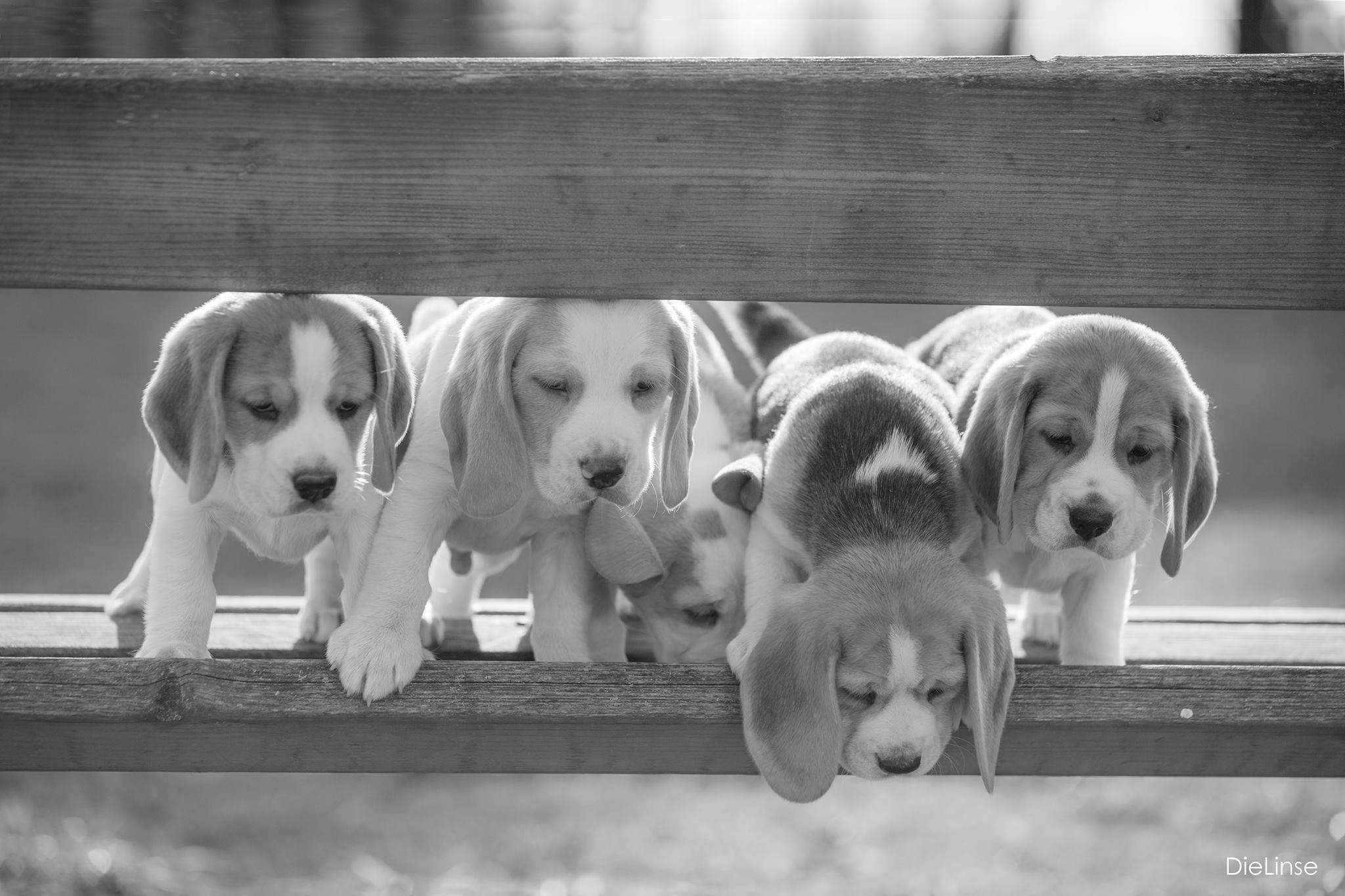Only a puppy that has learned to relax from an early age will be a pleasant companion as an adult dog that does not attract attention with constant barking, constant jumping up and nervousness!
Crate training for puppies
Beagles are an active breed and sometimes they will not be able to settle down on their own. They will follow their new family wherever they go. Curiosity usually wins over exhaustion. Beagles don't always show that they are tired and need rest, so we need to learn them to have nap times - once they are grown up you will be thankful for these tips because you will have a totally chilled dog in your everyday.
A dog crate helps to train the puppy to be calm and also helps by the housebreaking and later staying alone.
Do not consider a crate as a "prison" for your dog. A crate is a tool, which helps both us and our dogs in some situations. A dog crate is a kind of playpen in which the dog is “safe” and finds peace and quiet, since dogs love caves and like to sleep there.
Incidentally, an beagle who is used to a dog crate will also have fewer problems staying alone and the crate can also be useful on holidays, if you have to leave the dog alone in an unfamiliar area and protect the hotel room or holiday home from the dog's destructiveness and of course, want to protect the dog.
Note!
Adult dogs need between 17 and 20 hours of sleep (or rest periods) per day.
Puppies should rest and sleep for 20-22 hours!
Getting used to a crate
First, we stable boxes (plastic or metal). Unfortunately, textil boxes cannot withstand a puppy's urge to chew and are destroyed within 10 minutes. In addition, you should choose a box which can be easily cleaned.
You should set up the dog crate in your living room, not in the bedroom, hallway or another room where you rarely spend time. Puppies are nearly unable to be left alone for the first few weeks. The drive to stay with the pack is extremely strong, so place the dog crate within sight of you so that the puppy can see you.
It is best to choose a quiet, dark (!) corner. Dogs love corners and caves anyway because they feel particularly safe there. Don't put the box by the window, there is too much to see outside and the location is too bright to sleep. Make sure that there are no textiles such as curtains, blankets, pillows etc. or cables in the immediate vicinity of the box, as puppies are sometimes so creative that they manage to pull these textiles into the box and then do their mischief.
Be aware and don't leave objects in the crate which can lead to chewing and swallowing - like toys with small pieces and a filling, but use hard rubber toys, Nilabones, chewies according to the puppy's age or KONG. Think about which blanked or pillow you put in the crate - too much filling can lead to pillow explosions. The puppies should see the dog box as a place to sleep and retreat and not as a playground.
It is a good idea to feed the pup in the crate as he will now positively associate the crate with the food. To do this, lure the puppy to the box and put his food inside. At the beginning you put it all the way forward so that the puppy can eat from the outside. You should gradually push the bowl in further so that the dog disappears into the box.
If the puppy eats in peace, you can already lock the box door or lock. This way the puppy also positively associates being “locked in” with the food.
The dog thinks the box is really great if you throw small pieces of meat sausage or cheese into the box. He will rush into the box full of joy and get his treat. If you combine this action with a command, the dog will learn to go into its box on command. This exercise also helps the dog to keep checking back into the crate to see if there's still food in the crate, so feel free to put some treats in if the puppy isn't noticing.
To get further with the training, now it's time for you to calm him down, so you put the puppy in the box without comment and close the door. Immediately afterwards you open the box again and let the puppy out. Repeat this exercise several times and try to increase the time the dog has to remain in the box. First just a few seconds, then a few minutes. After several repetitions and that means dog in, door closed, door open again, let the dog come out, you can start to put the dog in the box and sit with your back in front of the closed box door. You should start with the training very rapidly when the puppy arrives to you, so you can make it easier. If you want to use the crate only later, and start after weeks with the training, it will make the boxing exercise all the more difficult. This is because over-excited puppies are very difficult to settle down and make even more noise when you try to calm them down.
So now you're sitting with your back in front of the closed box so you can't look at the puppy. If necessary, a blanket that you can put over the side of the box can help, so the puppy has it nice and dark and cozy and hopefully it will fall asleep faster. The puppy senses your presence in this way, but at the same time you cannot confirm him with looks. Sometimes just looking at the dog is enough for the pup to interpret their behavior as validation, and we don't want to teach the pup that rampaging is a great idea. Later (usually within a day or two) it is sufficient if you sit on the sofa within sight of the dog, for example. At first, you can gradually increase the distance by sitting a little further away from the box. Attention: We're talking about distances in the centimeter range here, don't jump away three meters straight away.
Now the hardest part. The world is collapsing for your puppy now, because he now realizes that he is locked in and can no longer make his own decisions. The puppy will now begin to whine, whine, howl, bark and depending on your puppy's temperament, the puppy will jump up and down in the crate looking for an exit. It is very important now that you do not positively support the puppy in its excitement (or negatively). That means don't look at the puppy, don't talk to him, don't pet him, don't feel sorry for him and definitely don't let him out of the box! If the puppy sleeps, then enjoy the peace and quiet and wait until it wakes up before opening the door again, otherwise the puppy will either wake up when the door is opened quietly or leave the open box unnoticed and do its business in the living area.
Now your patience and strong nerves are required and you have to wait until the puppy has calmed down and accepted his situation. This phase can last an hour or two, depending on how tired and strong-willed your puppy is. Only when the puppy is absolutely calm can you go over to it or turn around and open the door again. You just open the door without comment and let the puppy come out. Your puppy is now learning that being quiet is worth it, because then he can leave the box again.
You should practice this exercise as often as possible from the first day when your puppy is picked up, so that it can hopefully settle down in the crate by the evening without yelling too much, because then you can be sure of a reasonably quiet night, during which you only have to get up when your puppy is up to give a sign for needing to go out.
If you follow the guidelines and are consistent (let the dog out only when he's calm) then your puppy should accept the crate within a week and behave calmly when you put him in. He doesn't have to sleep every time, he can just watch you and have a rest.

